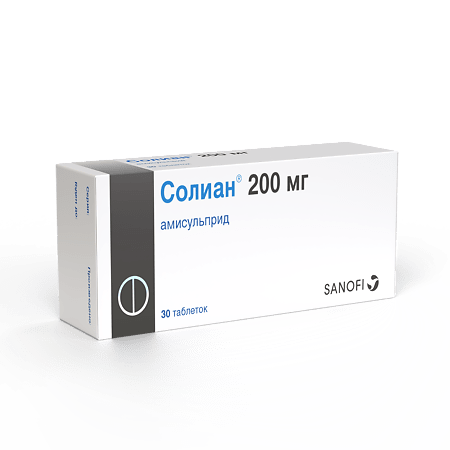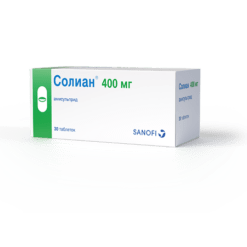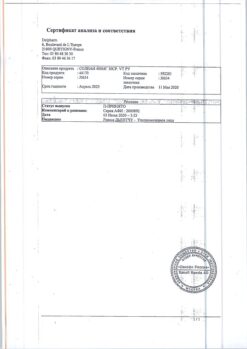No products in the cart.
Solian, tablets 200 mg 30 pcs
€1.00
Out of stock
(E-mail when Stock is available)
Description
Solian is an antipsychotic (neuroleptic)
Pharmacodynamics
. Amisulpride binds selectively, with high affinity, to D2/D3 subtypes of dopaminergic receptors, whereas it has no affinity for D1 D4 and D5 subtypes.
In contrast to classical and atypical neuroleptics, amisulpride has no affinity for serotonin receptors, histamine H1, alpha-adrenergic and cholinergic receptors. In addition, amisulpride does not bind to sigma receptors. When used in high doses, it blocks postsynaptic D2 receptors located in limbic structures, unlike similar receptors in the striatum. It does not cause catalepsy and does not lead to development of hypersensitivity of D2-dopamine receptors after repeated treatment.
In low doses, it predominantly blocks presynaptic D2/D3 receptors, causing the release of dopamine responsible for its disinhibitory effects. This atypical pharmacological profile may explain the antipsychotic effects of amisulpride at high doses resulting from blockade of postsynaptic dopamine receptors and its effectiveness against negative symptoms at low doses resulting from blockade of presynaptic dopamine receptors.
In addition, amisulpride is less likely to cause extrapyramidal side effects, which may be due to its predominant limbic activity.
In schizophrenic patients with acute seizures, Solian acts both on secondary negative symptoms and on affective symptoms such as depressed mood and retardation.
Pharmacokinetics
Amisulpride has two absorption peaks: one is reached rapidly, one hour after administration of the dose, and the second between 3 and 4 hours after administration. Plasma concentrations are 39 ± 3 and 54 ± 4 ng/mL, respectively, after administration of 50 mg.
The volume of distribution is 5.8 l/kg. Since the binding to plasma proteins is low (16%), interaction with other drugs is unlikely.
The absolute bioavailability is 48%. Amisulpride is poorly metabolized: (about 4%, two inactive metabolites have been identified. There is no cumulation of amisulpride and its pharmacokinetics remains unchanged after repeated doses.
The half-life (T1/2) of amisulpride is approximately 12 hours after an oral dose.
Amisulpride is excreted unchanged in the urine. Renal clearance is approximately 20 l/hour or 330 ml/min.
Carbohydrate-rich foods (containing 68% liquid) significantly decrease the AUC (area under the concentration/time curve), time to reach maximum concentration and maximum concentration of amisulpride itself, but no changes in pharmacokinetics were noted after eating fatty foods. However, the significance of these observations in routine clinical practice is unknown.
Hepatic impairment. Due to the fact that the drug is poorly metabolized, there is no need to reduce the dose for patients with hepatic impairment.
Hepatic impairment. The T1/2 in patients with renal impairment is not altered, but systemic clearance is reduced by a factor of 2.5 to 3. The AUC of amisulpride is doubled in mild renal insufficiency and almost tenfold in moderate insufficiency (see section Dosage and administration). Practical experience is limited, however, and there are no results for doses greater than 50 mg.
Amisulpride is poorly tolerated by dialysis.
Limited pharmacokinetic data for elderly (older than 65 years) patients indicate that Cmax, T1/2, and AUC are 10-30% higher after a single oral administration of 50 mg than in younger individuals. There are no data on the pharmacokinetics of the drug during long-term treatment.
Indications
Indications
Treatment of acute and chronic schizophrenia, accompanied by severe productive (for example: delusions, hallucinations, thinking disorders) and/or negative (for example: affective flatness, lack of emotionality and withdrawal from communication) disorders, including patients with a predominance of negative symptoms.
Pharmacological effect
Pharmacological effect
Solian – antipsychotic drug (neuroleptic)
Pharmacodynamics
Amisulpride selectively binds with high affinity to subtypes D2/D3 of dopaminergic receptors, while it has no affinity for subtypes D1, D4 and D5.
Unlike classical and atypical antipsychotics, amisulpride has no affinity for serotonin, histamine H1, alpha-adrenergic and cholinergic receptors. In addition, amisulpride does not bind to sigma sites. When used in high doses, it blocks postsynaptic D2 receptors localized in limbic structures, in contrast to similar receptors in the striatum. Does not cause catalepsy and does not lead to the development of hypersensitivity of D2-dopamine receptors after repeated treatment.
At low doses, it preferentially blocks presynaptic D2/D3 receptors, causing the release of dopamine, which is responsible for its disinhibitory effects. This atypical pharmacological profile may explain the antipsychotic effect of amisulpride at high doses, resulting from blockade of postsynaptic dopamine receptors, and its effectiveness against negative symptoms at low doses, resulting from blockade of presynaptic dopamine receptors.
In addition, amisulpride causes less extrapyramidal side effects, which may be due to its predominant limbic activity.
In patients with schizophrenia with acute attacks, Solian acts on both secondary negative symptoms and affective symptoms such as depressed mood and retardation.
Pharmacokinetics
Amisulpride has two absorption peaks: one is achieved quickly, one hour after dosing, and the second is reached between 3 and 4 hours after dosing. Plasma concentrations are respectively 39 ± 3 and 54 ± 4 ng/ml, after taking 50 mg.
The volume of distribution is 5.8 l/kg. Since plasma protein binding is low (16%), interaction with other drugs is unlikely.
Absolute bioavailability is 48%. Amisulpride metabolizes weakly: (about 4%, two inactive metabolites have been identified. Amisulpride does not accumulate, and its pharmacokinetics remains unchanged after repeated doses.
The half-life (T1/2) of amisulpride is approximately 12 hours after oral dosing.
Amisulpride is excreted unchanged in the urine. Renal clearance is approximately 20 l/hour or 330 ml/min.
A carbohydrate-rich meal (containing 68% liquid) significantly reduced the AUC (area under the concentration/time curve), time to maximum concentration and maximum concentration of amisulpride, but no changes in pharmacokinetics were noted after ingestion of a fatty meal. However, the significance of these observations in daily clinical practice is unknown.
Liver failure. Due to the fact that the drug is poorly metabolized, there is no need to reduce the dose for patients with liver dysfunction.
Kidney failure. T1/2 in patients with renal failure does not change, but systemic clearance decreases by a factor of 2.5 to 3. The AUC of amisulpride in mild renal failure doubles, and in moderate failure almost tenfold (see section Dosage and Administration). Practical experience, however, is limited and there are no results with doses exceeding 50 mg.
Amisulpride is poorly dialyzable.
Limited pharmacokinetic data for elderly (over 65 years of age) patients indicate that after a single 50 mg oral dose, Cmax, T1/2 and AUC are 10-30% higher than in younger adults. There are no data on the pharmacokinetics of the drug during long-term treatment.
Special instructions
Special instructions
According to a controlled, double-blind study comparing amisulpride and haloperidol in patients with acute schizophrenia (191 patients), a significantly greater reduction in secondary negative symptoms was observed with amisulpride. According to clinical studies, a significantly lower incidence of extrapyramidal symptoms was observed with the use of amisulpride than with the use of haloperidol.
As with the use of other antipsychotics, when using amisulpride (especially high doses), neuroleptic malignant syndrome may develop, characterized by hyperthermia, muscle rigidity, autonomic disorders, and increased levels of creatine phosphokinase. If hyperthermia develops, especially during the use of high doses of antipsychotics, all antipsychotic drugs, including amisulpride, should be discontinued.
Caution should be exercised when prescribing antidopaminergic drugs, and in particular amisulpride, for Parkinson’s disease, because when prescribed, the course of this disease may worsen. In patients with Parkinson’s disease, amisulpride should only be used if its use cannot be avoided. If treatment with amisulpride is necessary in a patient with Parkinson’s disease receiving dopaminergic agonists, dopaminergic agonists should be discontinued gradually (by gradually reducing the dose until they are completely discontinued) because Abrupt withdrawal may lead to the development of neuroleptic malignant syndrome.
To correct extrapyramidal symptoms that occur during treatment with amisulpride, anticholinergic antiparkinsonian drugs (rather than dopaminergic agonists) should be used.
Due to the fact that amisulpride causes a dose-dependent increase in the duration of the QT interval, its use increases the risk of developing paroxysmal tachycardias, including potentially life-threatening polymorphic ventricular tachycardia of the torsades de pointes type. Therefore, if the patient’s condition allows, before prescribing amisulpride, it is recommended to take an ECG and examine the electrolyte composition of the blood, identify and, if possible, correct factors that may contribute to the occurrence of dangerous rhythm disturbances (bradycardia less than 55 beats/min, hypokalemia, hypomagnesemia, congenital or acquired long QT interval, simultaneous use of drugs that can cause severe bradycardia (less than 55 beats/min), hypokalemia, slowing of intracardiac conduction, increase in the duration of the QT interval) (see “Interaction”).
During treatment with amisulpride, you should not take alcohol or drugs containing alcohol.
Due to the drug’s ability to lower the seizure threshold, when taking amisulpride in patients with epilepsy, they should undergo careful clinical and, if possible, EEG monitoring.
Some atypical antipsychotics, including amisulpride, may cause increases in blood glucose levels. In patients with diabetes mellitus and patients with risk factors for developing diabetes mellitus, blood glucose concentrations should be regularly monitored when amisulpride is prescribed.
In elderly patients, amisulpride, like other antipsychotics, should be used with extreme caution due to the possible risk of hypotension or excessive sedation.
In randomized clinical trials conducted in a group of elderly patients with dementia treated with certain atypical antipsychotic drugs, compared with placebo, a threefold increase in the risk of cerebrovascular events (acute cerebrovascular accidents) was observed. The mechanism for this increased risk is unknown. An increase in this risk cannot be excluded with the use of other antipsychotic drugs or in other patient groups. Amisulpride should be used with caution in patients with risk factors for stroke.
In elderly patients with dementia-related psychosis, an increased risk of death was observed when treated with antipsychotic drugs. An analysis of 17 placebo-controlled studies (mean duration greater than 10 weeks) found that most patients treated with atypical antipsychotics had a 1.6 to 1.7 times greater risk of death than patients treated with placebo. Although the causes of death in clinical studies with atypical antipsychotics varied, most causes of death were either cardiovascular (eg, heart failure, sudden death) or infectious (eg, pneumonia) in nature. Observational studies have confirmed that, like treatment with atypical antipsychotics, treatment with conventional antipsychotics may also increase mortality. The extent to which the increase in mortality may be due to the antipsychotic drug rather than certain patient characteristics is unclear.
Cases of venous thromboembolism, sometimes fatal, have been observed with the use of antipsychotic drugs. Therefore, amisulpride should be used with caution in patients with risk factors for thromboembolism (see “Side effects”).
Amisulpride is eliminated by the kidneys. If renal function is impaired, the dose of the drug should be reduced (see “Dosage and Administration”).
Impact on the ability to drive vehicles or other machinery. Patients, especially those who are drivers of vehicles or people who operate machinery, should be informed about the possibility of drowsiness and decreased psychomotor reactions while taking amisulpride, especially at the beginning of treatment, because this can be dangerous when driving vehicles or operating machinery.
Active ingredient
Active ingredient
Amisulpride
Composition
Composition
1 tablet contains
active ingredient: amisulpride – 200 mg; excipients: sodium carboxymethyl starch (sodium amylopectin glycolate) (type A), lactose monohydrate, microcrystalline cellulose, hypromellose, magnesium stearate.
Pregnancy
Pregnancy
The safety of taking amisulpride during pregnancy has not been established.
Therefore, the use of the drug during pregnancy is not recommended, except in cases where the expected benefit to the mother justifies the potential risk to the fetus.
Although there are no reported cases of side effects in newborns, theoretically, amisulpride, when used at the end of pregnancy and in high doses, can cause side effects in newborns (atropine-like effects: tachycardia, hyperreflexia, bloating, delayed passage of meconium; extrapyramidal symptoms: hypertonicity, tremor, sedation), and therefore they may require appropriate monitoring.
It is unknown whether amisulpride passes into breast milk, so breastfeeding while taking it is contraindicated.
Contraindications
Contraindications
Hypersensitivity to the active substance of the drug or to other components of Solian.
Concomitant prolactin-dependent tumors, for example: pituitary prolactinoma and breast cancer.
Pheochromocytoma.
Children’s age (up to 14 years).
Breastfeeding.
Combinations with the following drugs that can contribute to the development of atrial fibrillation: quinidine, disopyramide, amiodarone, sotalol, as well as bepridil, cisapride, sultopride, thioridazine, erythromycin, vincamine, halofantrine, pentamidine, sparfloxacin.
Combination with levodopa. (see section “Interaction with other drugs”).
With caution – pregnancy, epilepsy, parkinsonism, old age, renal failure.
Side Effects
Side Effects
Adverse reactions (HP) are presented in accordance with the following gradations of the frequency of their development: very often (≥10%); often (≥1%, <10%); uncommon (≥0.1%,<1%); rare (≥ 0.01%, < 0.1%); very rare, including isolated reports (<0.01%); frequency is unknown (it is not possible to determine the frequency of HP development based on available data).
Blood and lymphatic system disorders
Uncommon: leukopenia, neutropenia (see section “Special instructions”).
Rarely: agranulocytosis (see section “Special instructions”).
Immune system disorders
Uncommon: allergic reactions.
Endocrine system disorders
Often: amisulpride causes an increase in plasma concentrations of prolactin, which is reversible after discontinuation of the drug. This can lead to galactorrhea, amenorrhea, gyneocmastia, breast pain and erectile dysfunction.
Rare: benign pituitary tumor, such as prolactinoma.
Metabolic and nutritional disorders
Common: weight gain.
Uncommon: hyperglycemia (see sections “Precautions” and “Special Instructions”), hypertriglyceridemia, hypercholesterolemia.
Rarely: hyponatremia, syndrome of inappropriate secretion of antidiuretic hormone.
Mental disorders
Common: insomnia, anxiety, agitation, impaired orgasm (orgasmic dysfunction).
Uncommon: confusion.
Nervous system disorders
Very common: extrapyramidal symptoms (tremor, rigidity, hypokinesia, hypersalivation, akathisia, dyskinesia). These symptoms are usually mild when taken in optimal doses and are partially reversible with the addition of anticholinergic antiparkinsonian drugs without stopping treatment with amisulpride. The incidence of extrapyramidal symptoms depends on the dose. Therefore, in patients with predominantly negative symptoms taking amisulpride at a dose of 50-300 mg per day, the incidence of extrapyramidal disorders is very low.
According to clinical studies, a significantly lower incidence of extrapyramidal symptoms was observed with the use of amisulpride than with the use of haloperidol.
Common: acute dystonia (spasmodic torticollis, oculogyric crisis, trismus), reversible with the addition of anticholinergic antiparkinsonian drugs without stopping treatment with amisulpride; drowsiness.
Uncommon: tardive dyskinesia, characterized by rhythmic, involuntary movements mainly of the tongue and/or facial muscles, and usually occurs after long-term use of the drug (anticholinergic antiparkinsonian drugs in these cases are ineffective or may increase symptoms); convulsions.
Rare: neuroleptic malignant syndrome, which is a potentially fatal complication (see section “Special Instructions”).
Frequency unknown: restless legs syndrome with or without akathisia.
Visual disorders
Common: blurred vision.
Cardiac disorders
Uncommon: bradycardia.
Rarely: prolongation of the QT interval; ventricular rhythm disturbances, such as polymorphic ventricular tachycardia of the “pirouette” type, ventricular tachycardia, ventricular fibrillation, cardiac arrest and sudden death (see section “Special instructions”).
Vascular disorders
Common: decreased blood pressure.
Uncommon: increased blood pressure.
Rare: venous thromboembolic complications, including pulmonary embolism, sometimes fatal, and deep vein thrombosis (see section “Special Instructions”).
Respiratory, thoracic and mediastinal disorders
Uncommon: nasal congestion; aspiration pneumonia (mainly when used concomitantly with other antipsychotics and CNS depressants).
Gastrointestinal disorders
Common: constipation, nausea, vomiting, dry mouth.
Disorders of the liver and biliary tract
Uncommon: hepatocellular lesions.
Skin and subcutaneous tissue disorders
Rarely: angioedema, urticaria.
Frequency unknown: photosensitivity.
Musculoskeletal and connective tissue disorders
Uncommon: osteopenia, osteoporosis.
Renal and urinary tract disorders
Uncommon: urinary retention.
Injuries, complications and complications caused by manipulations
Frequency unknown: falls (sometimes leading to fractures) as a consequence of the development of adverse reactions associated with possible imbalance.
Pregnancy, postpartum and perinatal conditions
Not known: Withdrawal syndrome in newborns (see section
“Use during pregnancy and breastfeeding”).
Laboratory abnormalities
Uncommon: increased activity of liver enzymes in the blood, mainly transaminases.
Interaction
Interaction
Contraindicated combinations
Combinations that can cause torsade de pointes (TdP):
Class Ia antiarrhythmic drugs, such as quinidine, disopyramide.
Class III antiarrhythmic drugs, such as amiodarone, sotalol.
Other drugs such as bepridil, cisapride, sultopride, thioridazine, intravenous erythromycin, intravenous vincamine, halofantrine, pentamidine, sparfloxacin.
Levodopa: mutual antagonism of the effects of levodopa and antipsychotics.
Not recommended combinations
Amisulpride enhances the inhibitory effect of alcohol on the central nervous system.
Combinations requiring special care
Medicines that increase the risk of ventricular arrhythmia type “pirouette”:
Drugs that cause bradycardia, such as beta blockers, calcium channel blockers that cause bradycardia (diltiazem and verapamil), clonidine, guanfacine; Digitalis preparations.
Drugs that can cause hypokalemia: potassium-sparing diuretics, laxatives, amphotericin B, glucocorticoids, tetracosactides (hypokalemia should be corrected).
Neuroleptics such as pimozide, haloperidol; antidepressants such as imipramine; lithium.
Combinations to consider
Combination with drugs that depress the function of the central nervous system, including narcotic analgesics, antipsychotic drugs (neuroleptics), antihistamines with sedative effects, barbiturates, benzodiazepines and other anxiolytic drugs, a pronounced increase in the inhibitory effect. With antihypertensive drugs – increased antihypertensive effect.
Overdose
Overdose
Symptoms: Experience with amisulpride overdose is very limited. A significant increase in the known pharmacological effects of the drug has been reported, namely the development of drowsiness, sedation, coma, arterial hypotension and extrapyramidal symptoms.
It should be borne in mind that overdose phenomena can occur in cases of erroneous administration of additional doses of the drug or simultaneous use of other drugs.
Treatment: There is no specific antidote for amisulpride.
In case of overdose, the basic vital functions of the body should be monitored and maintained until the patient completely recovers from the overdose. In case of overdose, ECG monitoring is mandatory, because there is a risk of prolongation of the QT interval and the development of life-threatening arrhythmias (see “Side effects”).
If severe extrapyramidal symptoms occur, anticholinergic drugs should be used.
Because Since the elimination of amisulpride by hemodialysis is insignificant, the use of hemodialysis for its removal in case of overdose is inappropriate.
Storage conditions
Storage conditions
In a dry place, at a temperature not exceeding 25 °C
Shelf life
Shelf life
3 years
Manufacturer
Manufacturer
Delpharm Dijon, France
Additional information
| Shelf life | 3 years |
|---|---|
| Conditions of storage | In a dry place, at a temperature not exceeding 25 °C |
| Manufacturer | Delpharm Dijon, France |
| Medication form | pills |
| Brand | Delpharm Dijon |
Other forms…
Related products
Buy Solian, tablets 200 mg 30 pcs with delivery to USA, UK, Europe and over 120 other countries.















